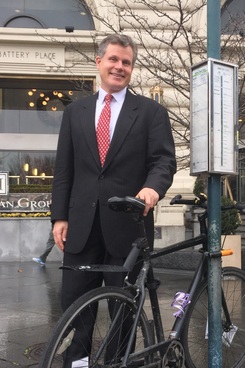In January of this year, the New York Law Journal Profiled our Steve Vaccaro. Read the whole profile here:
After 14 years as a litigator at Debevoise & Plimpton, Steve Vaccaro decided in 2010 that it was time to change gears.
Vaccaro did something that would be unthinkable to most of his fellow big law associates. Tapping his life savings and home equity loans, he hung up a shingle in the rough-and-tumble world of plaintiffs-side personal injury law.
Now, five years later, Vaccaro has more than found his feet. The fit, square-jawed 50-year-old is perhaps New York City’s best-known lawyer advocate for bicyclist and pedestrian rights. His personal injury clients include families of the poster children of the city’s “Vision Zero” movement, which aims to make city streets safer for pedestrians and cyclists. Last year he also helped to draft and promote a new city law that for the first time creates criminal penalties for drivers who strike pedestrians or cyclists who have the right of way.
“Driving is the most dangerous thing that most people do, the most likely to cause death to someone else,” says Vaccaro, “but we treat it as if it’s no more dangerous than eating dinner.”
Vaccaro should know: He cycles to work and court roughly 150 miles a week on his sturdy Surly Long Haul Trucker outfitted with collapsible metal panniers for his briefcase and files.
During a mid-December visit to his office overlooking Battery Park, the rooms were strewn with files related to the October 2013 death of 3-year-old Allison Liao, who was struck by a driver as she crossed a Queens street with her grandmother. Her family’s civil suit had just settled when the driver, who initially asserted that Liao had run in front of his car, recanted after being shown video of the crash that directly contradicted his testimony. And the cases just keep coming; a day earlier, Vaccaro had spent several hours with a new client, the family of yet another pedestrian fatally struck on a sidewalk.
“Ironically, I received a lots of training, informal as well as formal, in client counseling at Debevoise,” Vaccaro says. “But it is the individuals who need this most from their lawyers, not the institutional clients with internal general counsel.”
Fourteen cyclists and 117 pedestrians were killed by motorists in New York City between Jan. 1 and Nov. 30 of last year, according to official statistics, and thousands more were injured. The grim numbers ensure plenty of clients for Vaccaro, who no longer has to worry about the kinds of market fluctuations that were buffeting Debevoise during his final years there.
But there are different challenges: Motor vehicle litigation in New York County is “a bit of a mess,” Vaccaro says, with an “enormous number of cases consolidated under a single judge in a system not designed to promote speedy resolution.”
Cases often take three to four years to reach trial, and contingency fee-based firms have to underwrite the costs until a verdict or settlement. The longer they can support the case, the better the outcome for the client, Vaccaro says. “The early settlement offers are usually at a deep discount,” he says.
Mary Beth Hogan, Debevoise’s litigation chair, hired Vaccaro out of Rutgers School of Law-Newark in 1996 and remembers him as “very passionate about the cases he worked on, an intense advocate,” she says. He was also, she recalls, one of the few back then who commuted to the firm’s midtown office by bike.
Hogan said Vaccaro’s commitment to pro bono litigation stood out during his time at the firm. One of his cases accused the city and then-Police Commissioner Ray Kelly of violating the constitutional rights of cyclists involved in Critical Mass, a leaderless group of riders that gathers on the last Friday of every month in Manhattan for rides. The group had challenged parade regulations that made it illegal for a “recognizable group” of 50 or more individuals to participate in a procession without first obtaining a written permit.
Vaccaro says he first took up cycling after being mugged several times on his walk from high school to his home on the Upper West Side. “I reasoned that I’d be whizzing by so fast they wouldn’t have a chance to mug me,” he says. “And I wasn’t mugged again.” These days, in addition to his commuter bike, he rides a road bike on weekend trips—when he admits to being a MAMIL (middle-aged man in lycra). He’s continued in spite of suffering a fractured wrist and a torn meniscus in 2012, when a car turned in his path, and another fracture the first day he was back on his bike in 2013; both his children are avid urban cyclists as well, he says (and neither, he insists, will get a driver’s license anytime in the near future).
Despite the current administration’s expressed commitment to end all pedestrian and cyclist fatalities, Vaccaro says the city remains most focused on the interests of drivers.
“There needs to be a paradigm shift here,” he says. “The streets here are packed with people, there are millions of tourists, and they’re overflowing into the street, and then there are other people saying, ‘This is the road, it belongs to me, I’m in a car.’ They’re in a bubble, and they’re taking all sorts of risks.”
Visit here for the full report: http://www.americanlawyer.com/id=1202746207447/ExDebevoise-Litigator-Takes-On-NYCs-Mean-Streets#ixzz42QLACJRs

